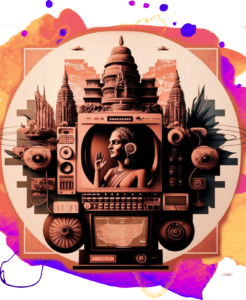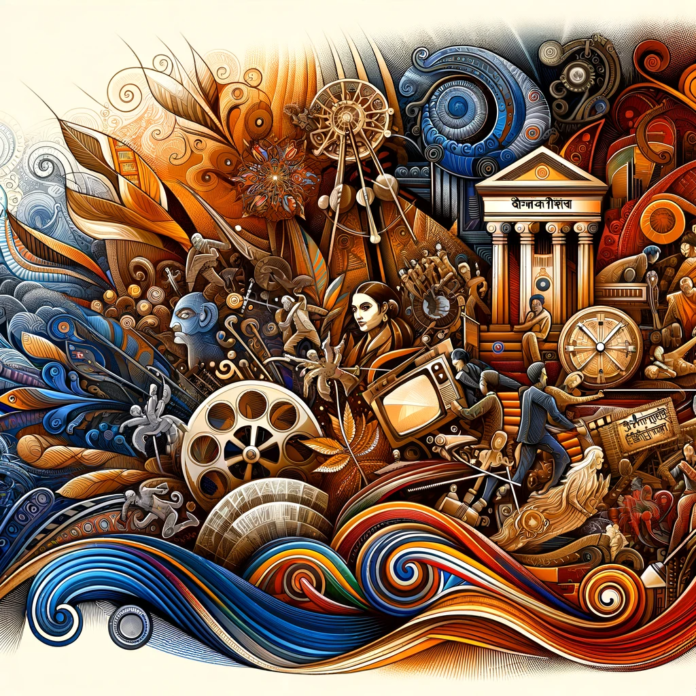Cinema is a universe that holds a world of talent, emotions, stories, music, and technology, all coming together to tell powerful visual tales.
The world of film today has developed a strong connection with people’s emotional, mental, and physical selves. Everything displayed on a screen is much more valuable than other forms. We may see several instances that have led to periods of celebrity worship where someone begins to imitate the star’s every move. We can see that fans have built shrines for their favourite celebrities in several areas of India.
On the other hand, they set up camps for blood donation, free tuition, camps for eye donation, or they perform some charitable acts on significant occasions like their birthday or wedding anniversary. We can infer that films are affecting the lives of people somewhere through these deeds and other cultural norms.
According to Jean Luc Godard’s adage, “Photography is truth.” Cinema is truth twenty-four times a second, which implies that it is more than just a format for narrating stories; it is also an effective medium that, in many instances, establishes a shared forum for both encoders and decoders, reflecting the idea that seeing is an act of believing.
How did the first phase of the Indian cinema launch period go?
Over the years, there has been a significant change in Indian cinema. From silent films in 1913 through the first talkies in 1931 to the coloured films of today, it all began. The socio-economic, political, and cultural developments in the nation are reflected in Indian cinema, along with all of its quirks. The historical feature picture Raja Harishchandra, which Dadasaheb Phalke released on May 3, 1913, earned him the title “father of Indian cinema.” On April 21, 1913, this motion picture had its debut. Shrikrishna Janma in 1917, Kaliya Mardan in 1919, and other films by Phalke also contained elements of nationalism. His films merged his idea of Swadeshi into the mythological genre and introduced it to Indian cinema. We can see that Dadasaheb Phalke didn’t select any other format or genre of film at this point in Indian cinema. Instead, he returned to the Bharatiya Culture’s origins to reawaken Indian society, which had become stronger through the Puranas, Bhagavad Geeta, Vedanta, and other ancient texts.
He might’ve felt that there was no better option to convince people than these stories. According to historical accounts, Phalke was a photographer and a professional printer interested in motion pictures. After watching The Life of Christ, he was struck by the possibility of making a film that would showcase Indian stories and traditions on the big screen. Phalke was particularly inspired by the film’s use of special effects and its ability to tell a story without dialogue, as he believed that these elements would make cinema accessible to a wider Indian audience. Inspired by these films, the youth then started making patriotic films. For instance, Baburao Painter and his Maharashtra Film Company made Kalyan Khajina(1924), Shahala Shah(1925) and others. These films stirred the masses into revolt.
How did the Talkie era respond to the earlier and contemporary phases?
The silent era ended when Ardeshir Irani produced his first talkie, ‘Alam Ara’ in 1931. If Phalke was the father of Indian cinema, Irani was the father of the talkie. The talkies changed the face of Indian cinema. Apart from looks, the actors not only needed a commanding voice but also singing skills, as music became a defining element in Indian cinema. The year also marked the beginning of the Talkie era in South Indian films. The first talkie films in Bengali (Jumai Shasthi), Telugu (Bhakta Prahlad) and Tamil (Kalidas) were also released in the same year. The thirties is recognized as the decade of social protest in the history of Indian Cinema. Three big banners – Prabhat, Bombay Talkies and New Theatres gave the lead in making serious but gripping and entertaining films for all classes of the wide audience. A number of films making a strong plea against social injustice were also made in this period, like V. Santharam’s Duniya na Mane, Aadmi and Padosi.
At the times of World War and Independence.
The 1940s were a turbulent decade, with the first half being torn apart by war and the second being marked by profound political change on a global scale. A significant success in Indian movie history, “Kismet,” starring Ashok Kumar, was released in 1943, right during the Second World War. The first anti-hero and an unmarried pregnancy were two of its striking topics. It was evident that the filmmakers of the time were more daring than the times they were working in where epic consciousness and the art of cinema were developing a strong relationship.
Golden Age Impact
The 1940s through 1960s were regarded as Indian cinema’s Golden Age. The Indian Cinema was greatly influenced by the first International Film Festival of India, which took place in early 1952 in Bombay. When Satyajit Ray and his crew arrived in 1955, things started to change. His timeless Pather Panchali, which paved the way for Indian cinema to enter the international forum, played a significant role in changing cinema’s taste, creating an efficient space for neorealism. Neorealism was the movement, especially in Italian filmmaking, characterized by simply depicting lower-class life.
The impact of neorealism was evident in some distinguished films like Bimal Roy’s Do Bigha ayal BaajZamin, Devadas and Madhumati; Rajkapoor’s Boot Polish, Shri-420 and Jagte Raho; V. Shantharam’s Do Aankhen Barah Haath and Jhanak Jhanak Pe; Mehboob’s Mother India; Gurudutt’s Pyaasa and Kagaz Ke Phool and B.R.Chopra’s Kaanoon. The sixties was a decade of mediocre films mainly made to please the distributors and, to some extent, meet the demands of the box office. Towards the end of the decade, Mrinal Sen’s Bhuvan Shome signalled the beginning of the new wave in Indian Cinema.
New Wave and New Millennium: How does the Evolution of Indian Cinema Looks like
The Hindi film business, in particular, saw a radical transformation throughout the 1970s. Movies and the businesses that produced them were influenced by shifting social conventions and shifting economic conditions. The tone of the story altered. The plot’s organization changed. Personas were altered. The content was altered. Masala films were popular during the time. The genre offered immediate appeal and high entertainment value. The gap between multi-star, high-budget, unconventional films grew even wider in the 1970s. Amitabh Bachchan gained popularity thanks to the success of Sholay, Zanjeer, and Deewar during the period known as the “age of the angry young man.” The women were not far behind as Dev Anand, Rajesh Khanna, Jitendra, and Dharmendra continued to revel in the glory of consecutive hits. From Savitri’s era forward To Sridevi, Rekha, Smita, Nargis, Waheeda Rahman, and Vyjayanthi Mala Patil, Hema Malini, and other actresses rose to fame as India’s heartthrobs. The new cinema movement continued with full spirit in the next decade (eighties). The 90s was a mixed genre of romantic, thrillers, action and comedy films Stars like Shah Rukh Khan, Rajnikanth, Madhuri Dixit, Salman Khan, Aamir Khan, Chiranjeevi, Juhi Chawla, etc.
Now that Indian cinema has entered the new millennium, there has been something of a revolution in how glamour, entertainment, commercial values, budgets, marketing, and box office reports are defined.
Conclusion
‘Cinema reflects culture, and there is no harm in adopting technology, but not at the cost of losing your originality.’;
Jackie Chan
Indian cinema reflects what Jackie Chan has said about Cinema and Culture and occasionally follows these guidelines. Many times, modern films and web series portray ideas like extreme feminism, nudity, pre-marital pregnancy, and LGBTQ as cool. However, most of the general public enjoyed value-driven films with strong Bharatiya cultural roots. For instance, the influence of films like Bahubali, Kantara, The Kashmir Files, The Vaccine War, Kartikeya, RRR, and Elephant Whisperers is entirely distinct from that of other kinds of films. Making people dream is not the primary purpose of cinema. It’s about bringing about change and stirring up thinking. Even though Western media influenced most movie stars and directors, some directors are still actively working to change society through the medium of film. Yes, throughout the entirety of this cinematic evolution.
Dexter and other similar films have recently impacted real life, as we have seen. The society had seen a string of these incidents immediately following one murder case. We can say that just as it is impossible to build an ideal society, every society will contain positive and negative ideas, ultimately leading to theatre, novels, films, etc. However, because Bharatiyas are Bharatiyas, the only expectation of regional people would be to portray regional culture in films. I hope the filmmakers will emphasise more on such aspects in the coming days.
At last, we can say that both cinema and society have mutually influenced each other. Even if one stays strongly rooted in ‘self’, it’ll make him stand out more than others.


